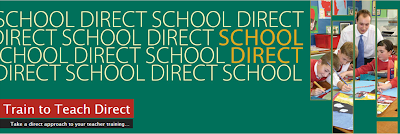A Game Changer
A change of government policy and the introduction of a new course called School Direct not only changes the rules of the game but also presents new challenges for student recruitment. Raising the awareness of new course provision can often be a challenge in itself, but with School Direct this responsibility doesn't just sit with the university that the school, or group of schools, have decided to go into partnership with, but also with the school itself.
As the higher education sector evolves and competition increases, universities are well used to marketing their provision and having a strategic approach to their student recruitment. There isn't a university in the country without a team of marketing specialists behind it for ensuring it recruits to target. And even then, some universities can still struggle to meet these targets, especially in recent years with the introduction of higher tuition fees. However, it is unlikely that the vast majority of schools will have the same marketing expertise, or budgets, to rely upon for recruitment to their allocated School Direct numbers. Nevertheless, in collaboration with their partner university, they must ensure that they do so.
For that reason, I thought I’d blog some advice and guidance on how schools might like to approach the marketing of their School Direct vacancies.
1. Raising Awareness and Understanding
There isn't currently a lot of awareness or understanding about this new course, so the first challenge is to raise awareness. The subsequent steps will explain more about how to do this, but first and foremost, you should make your marketing copy about School Direct easily accessible, clear and simple to understand.
With your website and advertising copy, avoid using ‘academic or business speak’ that might be difficult to understand, otherwise the prospect may simply not bother to read it and you’ll risk losing them at the first hurdle. Keep your copy short and to the point as well as relevant to the reader. Think about what they might want to know, engage them by focusing on what they value and enable them to take action. Remember that the role of your marketing communications isn't simply to raise awareness but to generate applications, so encourage them to get in touch so you can follow up on their interest.
2. Targeting and Media Selection
The first step in the buying decision-making process is need recognition, followed by information search and evaluation of alternatives. The need recognition of the prospect here is obviously the desire to teach, so think carefully about how to target these groups of people. If your marketing budget is tight, you won’t want to waste money advertising in the wrong places, so it is important to ensure that you have a well-defined target market.
Marketing a new course often involves a certain degree of trial and error. Therefore, an integrated approach that explores a variety of different media (print and on-line) is a sensible way of approaching this, not only to enable your message to be absorbed across a variety of different mediums, but also to enable you to explore what works and what doesn't.
Local Media
Often local press advertising is what a good number of my academic colleagues think of first, which is fine for general awareness raising in a targeted location, but this is a mass media route and, in the digital age, there are often far more cost effective ways of reaching your target market.
If you opt to advertise in the local press, my recommendation would be to advertise over a number of weeks in order to allow time for the advert to be noticed and absorbed. It is also worth negotiating on the cost and position of the ad in order to give it the best chance of being seen. If you have a small budget and you are unable to afford to advertise in the local press, it is often worth drafting together a newsworthy press release.
Digital Media
When considering options for advertising on-line, I would often recommend Pay-Per-Click (PPC) advertising. PPC is a cost effective and targeted way of driving more traffic to your website and consequently raising the awareness of your School Direct vacancies. PPC advertising can often provide a good return on investment (ROI) because it enables you to carefully target your key customer groups by their interests and location, and you’ll only get charged for the ad if the sponsored link is clicked.
Typically, all leading website search engines and social networking sites will enable you to create a PPC advertising campaign, so establish which the best sites for targeting potential trainee teachers are. Targeting through social networking sites can be done by basing your criteria on the demographics of your target audience. So, you’ll probably want to consider their education, interests, age and location. Targeting through search engines can be done by anticipating what keywords might be used by prospects searching for teacher training vacancies.
Targeting through search engines is often a good option here because, if done effectively, your ad will be targeted directly at prospects that are actively looking for vacancies on-line.
 |
| Google AdWords |
You can spend as much or as little as you like on PPC advertising, so set yourself a budget and set limits on the Cost-Per-Click (CPC). The ordering of your listing will depend on other advertisers’ bids (CPC) and the quality score (or relevance) of the ad shown for a given search. Assign a daily budget to your advertising campaign and monitor what is working and what is not.
Targeted Media and Events
 |
| Train to Teach Roadshow |
However, as well as specifically targeting those looking for teaching vacancies, you might like to look at raising the awareness amongst a specific group that are eligible to study the course. Recent graduates in the local area are the most obvious target group, especially for those harder to recruit STEM subjects. If the prospect is a graduate of the partner university, this will often make them a better lead because they already have an association to that institution and hopefully some loyalty to that brand.
3. Unique Selling Points
Given the variety of routes available to train as a teacher as well as the number of competitors also offering School Direct, your marketing communications should clearly identify the value of studying School Direct as opposed to another qualification and recognise what is unique about your offering. Only by demonstrating your unique selling points will you be able to establish your competitive advantage. Schools working in partnership with the University of Chester might not only wish to consider USPs within their school but also with the partnership. For instance, there is some real value in stating that you are working in partnership with a University that was the first purpose built teacher training college in the country and has an Ofsted ‘Outstanding’ status.
4. Engagement
If you are successful in generating some interest or applications in your School Direct vacancies, don’t make the mistake of thinking that the recruitment task is over. At all stages of recruitment, whether it is pre or post application, you should try to engage with your prospects and demonstrate a good level of customer care. This could make a real difference to the prospect’s perceptions of your school and the perceived level of support that is likely to be received once enrolled.
For this reason, every component of your promotional mix should encourage the prospect to get in touch. And when a prospect does contact you, ensure you have mechanisms in place for taking their details; data collection is the backbone of understanding who your prospects are and having the means to create a sustainable relationship with them. Without data collection, you are unable to track conversion of enquiries into enrolments and unable to influence the outcome of any enquiries past the stage of initial contact. Prospects could come and go, and you’ll risk failing to recruit to target.
Make time to follow up on your enquiries and ensure the prospect knows everything they need to about you to make an informed decision. Invite prospects into your school, meet them face-to-face and enable them to experience what it would be like to train at your school.
5. Monitor and Adjust
And finally, in order to gain the best return on investment, ensure you monitor and adjust you’re your marketing communications accordingly.
Check the analytics of any on-line marketing communications you do. Besides the targeting capabilities of on-line marketing, a digital campaign also enables you to monitor campaigns in ‘real time’ and adapt accordingly along the way.
If you opt to advertise through traditional print media it may be worth creating, and including in the ad, an isolated trackable URL (redirected to your existing School Direct web pages) so the success of the advert can be measured against the number of visits to this URL. However, should you decide to do this, the results should be observed with some caution, remembering that prospects may follow up by another means other than that specific URL. For this reason, it is always worth asking your prospects how they heard about your School Direct vacancies.
Ultimately, however, the most important metric to measure is the number of applications to your School Direct course. If applications aren't increasing as a result of your marketing communications, you’ll need to find out why as soon as possible. It could be down to a general lack of demand in the sector, but if it isn't you’ll need to implement a comprehensive review of your communications plan.
Until the next communication…
Adam



No comments:
Post a Comment
Thanks for your comment it has just gone to the approval queue